|
|
|
Sort Order |
|
|
|
Items / Page
|
|
|
|
|
|
|
| Srl | Item |
| 1 |
ID:
067416
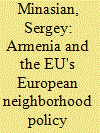

|
|
|
| 2 |
ID:
152472
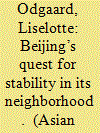

|
|
|
|
|
| Summary/Abstract |
Using the English school arguments that inter-state regulation ameliorates the consequences of the power politics of international anarchy, I analyze to what extent China pursues a strategic partnership with Russia in Central Asia. I investigate if China has compatible policies with Russia on the use of force, on international legitimacy, and on institutional frameworks for security management. As China is increasingly asserting its security, economic, and institutional interests in Central Asia, similarities and differences have become apparent in relations with Russia. Increased mutual concern for continued regional stability has encouraged Beijing and Moscow to coordinate their policies across a wide range of issue areas. Stability allows them to focus attention and resources on each of their different geostrategic priorities.
|
|
|
|
|
|
|
|
|
|
|
|
|
|
|
|
| 3 |
ID:
112966


|
|
|
|
|
| Publication |
2012.
|
| Summary/Abstract |
Ukraine is always said to be at a "crossroads." It has so many existential dilemmas of national identity and foreign policy direction. But this time its partners are demanding answers and its options really are narrowing. It is in danger of becoming a dysfunctional semi-autocracy and a double periphery rather than a mutual neighborhood.
|
|
|
|
|
|
|
|
|
|
|
|
|
|
|
|
| 4 |
ID:
107961


|
|
|
| 5 |
ID:
116620
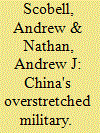

|
|
|
|
|
| Publication |
2012.
|
| Summary/Abstract |
Despite the dramatic growth of China's military power since the early 1990s, the Chinese People's Liberation Army (PLA), as all branches of China's armed forces are collectively known, remains overstretched as it seeks to address the wide range of missions it is called upon to perform. "China threat" theorists worry that the PLA poses a more significant challenge to the United States and China's neighbors than it did twenty years ago, and they are right. Yet the Chinese military is far from able to successfully carry out all its most pressing military tasks within China's borders and in its immediate neighborhood, and has only begun to project significant force beyond the Asia-Pacific.1 The real test for the PLA will be how adept it proves to be at bringing together new weapon systems, equipment, and formations in response to one or more serious instances of wartime or peacetime contingencies-a broad set of requirements the Chinese have dubbed "Diversified Military Tasks."2
|
|
|
|
|
|
|
|
|
|
|
|
|
|
|
|
| 6 |
ID:
138301


|
|
|
|
|
| Summary/Abstract |
What determines the location of those human rights international non-governmental organization (INGO) resources found outside of the highly developed Western democracies? We draw a distinction between the bottom-up mobilization processes driving the location of human rights organization (HRO) members from the top-down strategic concerns driving where HRO leaders place permanent offices. In particular, we find that, while political opportunity structures generally increase the likelihood that a state has HRO members, it has a curvilinear influence on the number of HRO secretariats, which typically locate in areas seen as having a higher need for organizational resources. Further, while there is no clear connection between human rights abuses and HRO memberships in a state, HROs' strategic concerns lead them to place offices with reference to both local and neighborhood “need”—in other words, levels of repression.
|
|
|
|
|
|
|
|
|
|
|
|
|
|
|
|
| 7 |
ID:
069418


|
|
|
| 8 |
ID:
086867


|
|
|
|
|
| Publication |
2009.
|
| Summary/Abstract |
When Junia Andrieux entered a money transfer agency in Miami's Little Haiti neighborhood on a recent Friday afternoon, the place was nearly empty, save for one other person ahead of her in line and a couple others being served by two clerks behind glass windows.
|
|
|
|
|
|
|
|
|
|
|
|
|
|
|
|
| 9 |
ID:
135467


|
|
|
|
|
| Summary/Abstract |
The UPA government had a broad approach to India’s emergence as a regional and global power but has never articulated it in terms of a strategy. In essence, it is to delay some of the instruments of power projection while India achieves economic development and growth with balance, in an effort to uplift all the Indian people. The focus of this policy is on the welfare of the people and consequent benefits of political consolidation, while not unduly constraining the reforms and growth needed to pay for them. Prominent risks to the strategy include the interlocking problems of security and governance.
|
|
|
|
|
|
|
|
|
|
|
|
|
|
|
|
| 10 |
ID:
100417
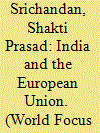

|
|
|
| 11 |
ID:
133119


|
|
|
|
|
| Publication |
2014,
|
| Summary/Abstract |
The built environment can be used to influence travel demand, but very few studies consider the relative energy savings of such policies in context of a complex urban system. This analysis quantifies the day-to-day and embodied energy consumption of four different neighborhoods in Austin, Texas, to examine how built environment variations influence various sources of urban energy consumption. A microsimulation combines models for petroleum use (from driving) and residential and commercial power and natural gas use with rigorously measured building stock and infrastructure materials quantities (to arrive at embodied energy). Results indicate that the more suburban neighborhoods, with mostly detached single-family homes, consume up to 320% more embodied energy, 150% more operational energy, and about 160% more total life-cycle energy (per capita) than a densely developed neighborhood with mostly low-rise-apartments and duplexes. Across all neighborhoods, operational energy use comprised 83 to 92% of total energy use, and transportation sources (including personal vehicles and transit, plus street, parking structure, and sidewalk infrastructure) made up 44 to 47% of the life-cycle energy demands tallied. Energy elasticity calculations across the neighborhoods suggest that increased population density and reduced residential unit size offer greatest life-cycle energy savings per capita, by reducing both operational demands from driving and home energy use, and from less embodied energy from construction. These results provide measurable metrics for comparing different neighborhood styles and develop a framework to anticipate energy-savings from changes in the built environment versus household energy efficiency.
|
|
|
|
|
|
|
|
|
|
|
|
|
|
|
|
| 12 |
ID:
135456


|
|
|
|
|
| Summary/Abstract |
PM Narendra Modi’s evolving India’s foreign policy is boldly marked with clear goals and objectives for aspiring India to become a serious and dominant player in the field of international affairs which, unfortunately, is characterised by super/ major power dominance and hegemony and utter lawless less and where naked power rules the roost. To deal such an ugly situation in international relations he has successfully chalked out a sound and effective strategy, meaning thereby, a method for use of social, economic, political, cultural, military, science &technological developments etc.
|
|
|
|
|
|
|
|
|
|
|
|
|
|
|
|
| 13 |
ID:
167852


|
|
|
|
|
| Summary/Abstract |
The Bharatiya Janata Party’s (BJP) election victory in May 2014 under the leadership of Narendra Modi saw the first parliamentary majority achieved by a single party in three decades. Both Indian and foreign observers of India’s foreign policy knew a little of Modi and the BJP’s approach to India’s external engagements. Modi’s image as a nationalist and strong leader led to the speculation that he would substantially change the direction of India’s foreign policy. This may be most visible in India’s “Neighborhood-First” Initiative (NFI). This study focuses on Modi’s neighborhood policy. It gives an overview of how the Modi government is redefining India’s neighborhood policy and considers the new vision and approach that the Modi government is pursuing with India’s neighborhood. It is followed by an assessment of difficulties in putting the policy into practice. Finally, it discusses responses from China and summarizes key points in the concluding section.
|
|
|
|
|
|
|
|
|
|
|
|
|
|
|
|
| 14 |
ID:
130975


|
|
|
|
|
| Publication |
2014.
|
| Summary/Abstract |
The present paper investigates how neighborhood effects are connected to chronic poverty. We examine a large sample of groups of households and find that neighborhood effects are significant in a majority of groups, especially in the poorest groups. People living in poor communities tend to suffer from poverty over time. It is of theoretical and empirical importance to explore how neighborhood effects are interrelated with chronic poverty and the channels through which this occurs. Unlike other econometric analyses, we establish a multilevel econometric model to show that: (i) it is difficult for an individual living in a neighborhood with a high proportion of agricultural labor, low education levels, and poor transport and telecommunication infrastructure to escape from poverty traps; (ii) neighborhood effects dominate in poor communities; and (iii) although poverty is affected by group-level factors, individual factors still play a dominant role in regards to escaping poverty when income surpasses a threshold level. Therefore, policy priority should be given to providing social protection and public services, especially in poor rural areas
|
|
|
|
|
|
|
|
|
|
|
|
|
|
|
|
| 15 |
ID:
107308
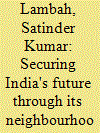

|
|
|
| 16 |
ID:
132294
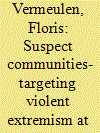

|
|
|
|
|
| Publication |
2014.
|
| Summary/Abstract |
Throughout Europe, authorities have set up new policy measures and programs to curb homegrown violent extremists. This article describes local policy responses to violent Islamic extremism-and/or the mere threat of it-in the neighborhoods Oost in Amsterdam, Moabit and Soldiner Kiez in Berlin, and Tower Hamlets in London. Based on locally conducted fieldwork, the study compares and contrasts these neighborhoods' approaches and aims to make a first assessment of their effects. A major finding for all three cities is that authorities target the entire local Muslim community rather than a few select individuals. This can lead to the construction of suspect communities, an approach with possible paradoxical effects on targeting actual violent extremists. Suspect communities subsequently create stigmatization, exclusion, and possibly marginalization, which not only has negative consequences for involved groups, but may well produce a breeding ground for future violence. However, the author did not find that engagement with Islamic organizations or individuals was used to directly change the nature of local Muslim communities. Orthodox and non-violent extremist organizations and individuals in all three cities were potential partners for engagement, which probably lowers the chance of stigmatizing the suspect communities.
|
|
|
|
|
|
|
|
|
|
|
|
|
|
|
|
| 17 |
ID:
116401


|
|
|
|
|
| Publication |
2012.
|
| Summary/Abstract |
This article argues that a synthetic look at different dimensions of Turkey's engagement of its neighborhood, be it movement of people, civil society interactions and economic exchanges, offers a better understanding of both the broader context within which Turkey's foreign policy is changing and the precise modalities through which this transformation is taking place. This engagement offers a range of opportunities from assisting neighboring countries, including the Arab world, to reform and modernize economically as well as politically to nudging the neighborhood to seek greater interdependence, dialog and cooperation. This would be promising in terms of "win-win" outcomes for Turkey, the European Union (EU) and the region. Such an interdependent and integrated neighborhood around Turkey could unleash economic, social and political processes that may eventually lead to a "democratic peace" in the region even if it might be in the very distant future. However, a number of tough challenges from reinvigorating democratization in Turkey and revitalizing EU-Turkish relations to stubborn regional conflicts would have to be addressed. Governments as well as civil society, academia and the think-tank world ought to start to think about what to do with these challenges.
|
|
|
|
|
|
|
|
|
|
|
|
|
|
|
|
|
|
|
|
|